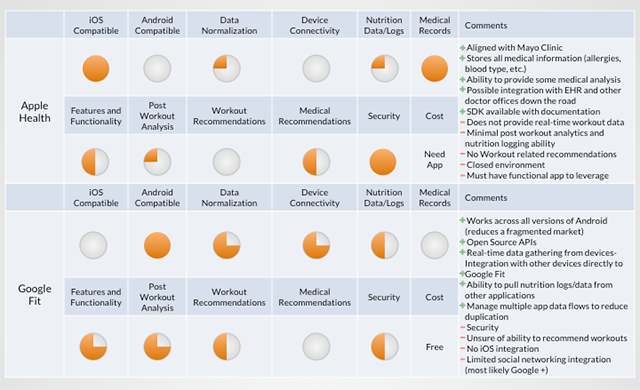Apple Health vs. Google Fit – The Tale of the Tape
The stage has been set for a heavyweight battle: Apple Health vs. Google Fit. Two juggernauts are about to square off to vie for control of an already-saturated health monitoring and mobile fitness market.
The only problem with the showdown is that it’s really not an Apple vs. Google fight; the two companies currently have wildly different product visions, at least if you are comparing Apple Health, which will be powered by data from HealthKit, and Google Fit.
In one corner we have Apple Health, Apple’s new health app that currently focuses on the healthcare industry and obtaining information from other applications to provide high-level analytics around health in general.
In the other is Google Fit, a new development platform for health and fitness apps that’s being positioned as one with a low barrier to entry for manufacturers looking to quickly build for an ecosystem that is backed by the power of Google and its Android OS.
For the purposes of this post, we’ll be taking a look at what both companies have in mind for their recently unveiled health and fitness solutions.
Apple Health now, & Apple Health post-iWatch
Apple Health can be viewed in two ways. Health now, and Health post-iWatch.
For now, Health seems to be focused on general health information (blood pressure, immunizations, glucose levels, etc.) and app-to-app data sharing through HealthKit APIs.
For users to store personal medical information from Health, they need to manually input their information into the app. The other way to load data into Health is for app developers to leverage HealthKit’s APIs for communication with Health.
Health, at this moment, does not allow fitness devices to leverage Health as a real-time application for measuring working outs or providing other complex post workout analytics. It also cannot provide complex analytics from the data obtained from app-to-app sharing.
Health, post-iWatch, may change to become the biometric data analysis software for the rumored iWatch. I suspect that the iWatch will have a myriad of sensors to capture not just heart rate, body temperature, and activity level, but even things like perspiration and UV levels. These metrics will be transferred through Bluetooth low energy, or potentially not connected to your phone at all and sent directly to iCloud.
iWatch will be like Fitbit on steroids. A product like this, combined with Health for analytics, could be wildly successful. The iWatch could be the ultimate savior for Health, as Apple just released its next beta of the Health app, which just so happens to include passive step counting and the ability to manage step data. This is a strong indicator that Apple Health will be the software component of the iWatch.
I believe that iWatch will make Health relevant. It will take an app that was more of a hub of data into an app that can now provide a deeper level of analytics and provide a more interactive experience. Without iWatch, Health is destined to be just another Passbook, which to date has been seen as a great idea, but an overall failure due to poor execution.
Health will have initial shortfalls but will get a nice boost from the introduction of the iWatch, whenever that product is released. Where it goes from there depends largely on how the healthcare industry adopts it. Until then, Apple will be reliant on third-party applications and their integrations with the newly unveiled HealthKit to keep pace with Google.
Google Fit – Fit (Enough) for Public Consumption?
Google Fit seems to be focused on providing a low barrier to entry ecosystem for fitness device manufacturers to address the needs of the current social exerciser – someone that works out between 2 and 4 times a week.
Through the use of three main application programming interfaces (APIs), Google Fit will read data from devices, record/store data from devices and other applications in real-time, and allow the user to merge and manage data inputs. The latter is crucial to avoid duplicating data from two applications/devices capturing similar information.
Like most of Google’s APIs, these will more than likely be free and open source for everyone. Data captured through Google Fit will likely be uploaded to Google’s servers for more trending and testing, akin to what they did with search data on flu symptoms to predict flu outbreaks across the country in their “Google Flu” web app.
These APIs will most likely need to be aggregated with other APIs on the market for GPS, social media, gamification, etc. to create a complete application. Google has stated that these APIs will be compatible with all current and future platforms and devices making up the Android universe. This is something developers of Android will welcome with open arms.
An example of how Google Fit will help device manufacturers enter the market is through the upcoming release of Adidas’ fitness wearable device, MiCoach FitSmart. Adidas is not in the software development business, but through the use of Google Fit, Adidas is able to release the device through the Google Fit platform. By leveraging Google Fit, Adidas is able to get to market much faster than it would if it were to have to create an application from scratch.
Wrapping it All Up
Time will tell just how much Apple and Google will fare in the health and fitness monitoring market. There are major market disruptions to look out for, like the iWatch. There is also the possibility of Amazon entering the market or the possibility of Samsung’s open platform architecture, S.A.M.I., taking off. In my opinion, until the iWatch comes out, Google is in a better position to provide manufacturers and consumers with an all-encompassing health and fitness app than the rest of the other major players.
Recent blog posts

Stay in Touch
Keep your competitive edge – subscribe to our newsletter for updates on emerging software engineering, data and AI, and cloud technology trends.




